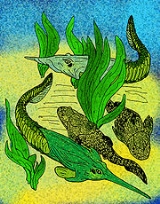
Pituriaspida
Encyclopedia
The Pituriaspida are a small group of extinct armored jawless fishes with tremendous nose-like rostrum
s, which lived in the marine, deltaic environments of Middle Devonian Australia (about 390 Ma). They are known only by two species, Pituriaspis doylei
and Neeyambaspis enigmatica
found in a single sandstone location of the Georgina Basin
, in Western Queensland
, Australia
.
"Pituriaspida" is often mistranslated as "hallucigenic shield." "Pituri" is actually a specific kind of hallucigenic drug, made from the leaves of the Corkwood Tree
and Acacia
ash, used by local Aborigine
shamans for vision quests. The pituriaspids' discoverer, Dr Gavin Young, named Pituriaspis after the drug, because, upon examining the first specimens, he suspected he was hallucinating (Long, p 59). The better studied species - Pituriaspis doylei
, which had a superficial resemblance to the Osteostraci
, had an elongate headshield, that, coupled with its spear-like rostrum, gave it a throwing-dart-like appearance. Neeyambaspis enigmatica
had a much smaller and shorter rostrum, and a more triangular headshield, making it look as though it were a guitar
pick with a tail.
Rostrum (anatomy)
The term rostrum is used for a number of unrelated structures in different groups of animals:*In crustaceans, the rostrum is the forward extension of the carapace in front of the eyes....
s, which lived in the marine, deltaic environments of Middle Devonian Australia (about 390 Ma). They are known only by two species, Pituriaspis doylei
Pituriaspis doylei
Pituriaspis doylei was one of two known species of jawless fish belonging to the Class Pituriaspida, and is the better known of the two. The species lived in estuaries during the Middle Devonian, in what is now the Georgina Basin of Western Queensland, Australia.The first specimens of P...
and Neeyambaspis enigmatica
Neeyambaspis enigmatica
Neeyambaspis enigmatica is the lesser known of the two species of pituriaspid agnathans. The species lived in estuaries during the Middle Devonian, in what is now the Georgina Basin of Western Queensland, Australia....
found in a single sandstone location of the Georgina Basin
Georgina Basin
The Georgina Basin is a large intracratonic sedimentary basin in central and northern Australia, lying mostly within the Northern Territory and partly within Queensland. It is named after the Georgina River which drains part of the basin. Deposition of locally up to ca...
, in Western Queensland
Queensland
Queensland is a state of Australia, occupying the north-eastern section of the mainland continent. It is bordered by the Northern Territory, South Australia and New South Wales to the west, south-west and south respectively. To the east, Queensland is bordered by the Coral Sea and Pacific Ocean...
, Australia
Australia
Australia , officially the Commonwealth of Australia, is a country in the Southern Hemisphere comprising the mainland of the Australian continent, the island of Tasmania, and numerous smaller islands in the Indian and Pacific Oceans. It is the world's sixth-largest country by total area...
.
"Pituriaspida" is often mistranslated as "hallucigenic shield." "Pituri" is actually a specific kind of hallucigenic drug, made from the leaves of the Corkwood Tree
Duboisia
Duboisia is a genus of small perennial shrubs to trees about 14 m tall, with extremely light wood and a thick corky bark. There are four species; all occur in Australia, and one also occurs in New Caledonia....
and Acacia
Acacia
Acacia is a genus of shrubs and trees belonging to the subfamily Mimosoideae of the family Fabaceae, first described in Africa by the Swedish botanist Carl Linnaeus in 1773. Many non-Australian species tend to be thorny, whereas the majority of Australian acacias are not...
ash, used by local Aborigine
Indigenous Australians
Indigenous Australians are the original inhabitants of the Australian continent and nearby islands. The Aboriginal Indigenous Australians migrated from the Indian continent around 75,000 to 100,000 years ago....
shamans for vision quests. The pituriaspids' discoverer, Dr Gavin Young, named Pituriaspis after the drug, because, upon examining the first specimens, he suspected he was hallucinating (Long, p 59). The better studied species - Pituriaspis doylei
Pituriaspis doylei
Pituriaspis doylei was one of two known species of jawless fish belonging to the Class Pituriaspida, and is the better known of the two. The species lived in estuaries during the Middle Devonian, in what is now the Georgina Basin of Western Queensland, Australia.The first specimens of P...
, which had a superficial resemblance to the Osteostraci
Osteostraci
The class Osteostraci was a group of bony-armored jawless fish, termed "ostracoderms", that lived in what is now North America, Europe and Russia from the Middle Silurian to Late Devonian....
, had an elongate headshield, that, coupled with its spear-like rostrum, gave it a throwing-dart-like appearance. Neeyambaspis enigmatica
Neeyambaspis enigmatica
Neeyambaspis enigmatica is the lesser known of the two species of pituriaspid agnathans. The species lived in estuaries during the Middle Devonian, in what is now the Georgina Basin of Western Queensland, Australia....
had a much smaller and shorter rostrum, and a more triangular headshield, making it look as though it were a guitar
Guitar
The guitar is a plucked string instrument, usually played with fingers or a pick. The guitar consists of a body with a rigid neck to which the strings, generally six in number, are attached. Guitars are traditionally constructed of various woods and strung with animal gut or, more recently, with...
pick with a tail.

